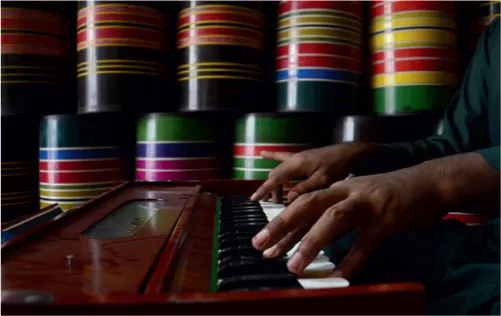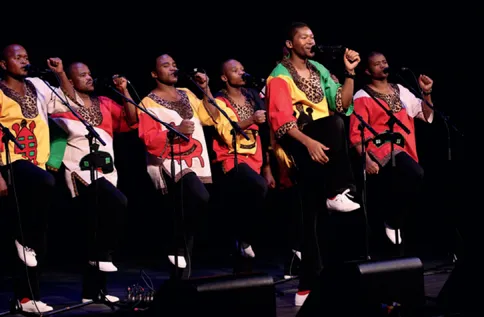
eBook - ePub
Excursions in World Music, Seventh Edition
eBook & mp3 Value Pack
- 515 pages
- English
- ePUB (mobile friendly)
- Available on iOS & Android
eBook - ePub
About this book
Excursions in World Music is a comprehensive introductory textbook to world music, creating a panoramic experience for students by engaging the many cultures around the globe and highlighting the sheer diversity to be experienced in the world of music. At the same time, the text illustrates the often profound ways through which a deeper exploration of these many different communities can reveal overlaps, shared horizons, and common concerns in spite of and, because of, this very diversity.
The new seventh edition introduces five brand new chapters, including chapters by three new contributors on the Middle East, South Asia, and Korea, as well as a new chapter on Latin America along with a new introduction written by Timothy Rommen. General updates have been made to other chapters, replacing visuals and updating charts/statistics. Excursions in World Music remains a favourite among ethnomusicologists who want students to explore the in-depth knowledge and scholarship that animates regional studies of world music.
Frequently asked questions
Yes, you can cancel anytime from the Subscription tab in your account settings on the Perlego website. Your subscription will stay active until the end of your current billing period. Learn how to cancel your subscription.
At the moment all of our mobile-responsive ePub books are available to download via the app. Most of our PDFs are also available to download and we're working on making the final remaining ones downloadable now. Learn more here.
Perlego offers two plans: Essential and Complete
- Essential is ideal for learners and professionals who enjoy exploring a wide range of subjects. Access the Essential Library with 800,000+ trusted titles and best-sellers across business, personal growth, and the humanities. Includes unlimited reading time and Standard Read Aloud voice.
- Complete: Perfect for advanced learners and researchers needing full, unrestricted access. Unlock 1.4M+ books across hundreds of subjects, including academic and specialized titles. The Complete Plan also includes advanced features like Premium Read Aloud and Research Assistant.
We are an online textbook subscription service, where you can get access to an entire online library for less than the price of a single book per month. With over 1 million books across 1000+ topics, we’ve got you covered! Learn more here.
Look out for the read-aloud symbol on your next book to see if you can listen to it. The read-aloud tool reads text aloud for you, highlighting the text as it is being read. You can pause it, speed it up and slow it down. Learn more here.
Yes! You can use the Perlego app on both iOS or Android devices to read anytime, anywhere — even offline. Perfect for commutes or when you’re on the go.
Please note we cannot support devices running on iOS 13 and Android 7 or earlier. Learn more about using the app.
Please note we cannot support devices running on iOS 13 and Android 7 or earlier. Learn more about using the app.
Yes, you can access Excursions in World Music, Seventh Edition by Bruno Nettl, Timothy Rommen in PDF and/or ePUB format, as well as other popular books in Medios de comunicación y artes escénicas & Etnomusicología. We have over one million books available in our catalogue for you to explore.
Information

© Getty
CHAPTER
1
INTRODUCTION
Studying Musics of the World’s Cultures
For some people, when you say “Timbuktu” it is like the end of the world, but that is not true.
I am from Timbuktu, and I can tell you we are right at the heart of the world.
Ali Farka Touré, liner notes, Talking Timbuktu
A CONCERT AT THE MANN CENTER
It’s a beautiful summer evening and my daughter, Natalia, and I have just managed to find our seats at the Mann Center for the Performing Arts in Philadelphia, PA. The Center is presenting a double billing that has brought people out en masse. It’s still an hour before show time, and already the amphitheater is full. The lawn behind the covered seating area, moreover, is almost completely covered in blankets and lawn chairs as patrons mill about, making preparations for the evening’s entertainment. Natalia and I have been looking forward to this evening, because we’re going to hear the South African vocal group, Ladysmith Black Mambazo, open a show that also features the famous gospel group, the Blind Boys of Alabama. Both of these Grammy Award-winning ensembles are iconic in their own way, the former for showcasing a South African style of singing called isicathamiya and the latter for sustaining upwards of seven decades of innovation within the African American gospel tradition in the United States (the group was founded in 1939). Both of these groups have achieved notoriety within their respective national contexts and have also garnered tremendous international fame. Ladysmith Black Mambazo tours extensively and visits the United States regularly. The Blind Boys of Alabama are also veterans of heavy international touring schedules.
Ladysmith Black Mambazo take the stage around 8 pm and perform their trademark show, complete with stories from Joseph Shabalala, the group’s leader and principal arranger, humorous and playful interactions between members of the ensemble, choreographed dancing, heavy on Zulu aesthetics, and, of course, complete control over their subtle and virtuosic vocal production. Most of the songs are sung in languages like Zulu and Sotho, and only a few are performed in English. The Blind Boys of Alabama, for their part, take everyone to “church.” Dressed in matching, bright blue suits and gathering emotional momentum as the set wears on, they call boisterously to the audience for participation (and receive it), tell jokes, and generally put on a great show, singing in their trademark, close harmony while treating us to a series of gospel standards. The concert, as it turns out, is amazing, and both groups live up to their considerable reputations, leaving the audience buzzing about the night’s musical experiences.
As Natalia and I walk to the parking lot, I am struck by how well this concert highlights many of the issues with which ethnomusicologists (and this book) are concerned. For instance, the concert offers a glimpse at the ambiguity inherent in the terminology we use to discuss the music of groups like Ladysmith Black Mambazo. The music industry, based largely in the North Atlantic, tends to market groups like Ladysmith Black Mambazo as “World Music,” whereas the Blind Boys of Alabama are categorized as “gospel” musicians. Ironically, the expansive-sounding label—World Music—achieves a rather delimiting effect. It inscribes difference, otherness, and, at times, exoticism onto musical practices that do not squarely fit into North Atlantic modes of traditional, popular, or art music. The many musics of the world are, thus, homogenized into a category that serves as a catch-all for the performances of artists who, unlike, say, the Blind Boys of Alabama, do not sing primarily in English and do not, generally, hail from a North Atlantic nation-state.

Ladysmith Black Mambazo. Source: Steve Mack/Getty

Blind Boys of Alabama. Source: Przemek Tokar/Shutterstock.com
And yet, both of these groups are clearly “world musicians” in the broadest and best sense of the word—in the sense that opens the world to new sounds, new encounters, and new possibilities. The authors of this book explore the world’s music in this broad, open-ended way. They consider each of the many musics of the world as offering meaningful and vital experiences both on the local and translocal levels. In this book, the authors explore how music functions in communities throughout the world; how musical practice intersects with politics and economics; how it is bound up in questions of ethnicity, class, race, and identity; how religion, aesthetics, and ideology affect the production and consumption of music; and how dance and art are intertwined with it, to name but a few of the book’s major themes.
Setting its flaws and ambiguities aside for a moment, however, the music industry markets “World Music” with recourse to difference precisely because it is a quantifiable (if often over-determined and essentialized) performative and sonic reality. Indeed, the musics of the world are endlessly diverse. This evening’s musical performances offer a good case in point, for the styles of these two groups are quite different from each other. Ladysmith Black Mambazo sing relatively softly, though there are many members in the group, while the Blind Boys of Alabama are few in number but are very loud in terms of their vocal production. Ladysmith’s music is called isicathamiya, a Zulu-derived word that means something like “walk softly,” and which conveys in the name of the genre itself the necessity for the low volume required of the early performers and innovators of this style. These performers, active in the early decades of the twentieth century, were employed as migrant laborers at South African mines and thus lived in the mine barracks. Their after-hours singing and dancing needed to be quiet enough so that the camp security would not notice and come shut them down. The gospel music sung by the Blind Boys, by contrast, is rooted in the notion of proclamation and is, thus, intended to be heard both far and wide.
Ladysmith works with small units of musical material that they gradually transform over the course of performances often lasting more than ten minutes, a compositional technique sometimes referred to as cellular construction and a hallmark of many sub-Saharan African musical traditions (see Chapter 8). The Blind Boys work mostly within a shorter, verse-chorus structure that easily opens up to an improvisatory vamp toward the end of the song—a vamp that can extend these three- or four-minute compositions to well over ten minutes as well. Ladysmith is an a capella group, which means that they sing unaccompanied by instruments, once again because the genre developed within a context where playing instruments would have, in many cases, been impractical. The Blind Boys, though, travel with a small gospel band (organ/piano, guitar, bass, drums). One group sings primarily in African languages; the other sings exclusively in English.
These divergent approaches to musical structure, aesthetics, language, dance, and style suggest an important way of thinking about musical difference: Difference, like sameness, is best understood as a matter of perspective. Sameness is constructed out of identifying difference and, as such, is bound up in who you are, the experiences you’ve been in a position to accumulate, and the traditions from which you are selecting in the process of assembling your own sense of the world. As we all know, throughout history, difference has been mobilized to tragically destructive purpose—genocide, slavery, the holocaust, exile, religious fundamentalisms, and exoticisms of one stripe or another have all been justified through such mobilizations of difference. And yet, difference can also become truly productive if it is mobilized in service of mutual exchange and open encounter. It is in this sense that ethnomusicology is engaged with the musics of the world.
Importantly, acknowledging the ways that the musics of the world differ from each other can (and often does) lead to new insights and to rich and meaningful musical encounters that illustrate sameness, solidarity, and shared horizons. Difference can, in other words, enable us to see (and hear) ourselves in the other and the other in ourselves. This is especially the case if we approach these musical encounters open to the possibility that our own perspective is subject to reinterpretation and to change in the face of new experiences. Returning to this evening’s concert, these two ensembles share several significant themes in common. First, both groups have overcome devastating social inequality tied to race and class. Ladysmith Black Mambazo was formed during the height of the Apartheid regime in South Africa, while the Blind Boys of Alabama have lived and performed through Jim Crow laws and the Civil Rights Movement in the United States. In this sense, both groups have been affected by the prior and unequal movements of money, goods, and people that characterized the colonial period. Ladysmith’s ancestors were witness to the colonial subjugation of the Zulu and the successive injustices that culminated in Apartheid. The ancestral heritage of the Blind Boys is rooted in West Africa, the slave trade, and the southern plantation economy. Both groups have chosen to perform music of deep spiritual significance, raising their voices in defense of social justice and contributing in significant ways to the ongoing process of articulating a way forward after Apartheid and in building on the as yet unfulfilled promise of the Civil Rights Movement, respectively.
Both groups have also benefitted from the long-term exchange of musical practices. This exchange has seen African practices inform musical lives throughout the African diaspora, including the musical practices of African Americans and Afro-Caribbean communities. As such, a whole host of musical ideas—often called African retentions, and including instruments, drumming styles, ensemble structures, dance styles, and rhythmic cells—have been incorporated into and adapted to the musical contexts of traditional, sacred, and popular musics throughout the African diaspora. This exchange has also witnessed the return of new genres and practices from the diaspora to Africa. For instance, isicathamiya is, itself, informed by the sounds of the vaudeville and ragtime groups such as the Virginia Jubilee Singers and Orpheus McAdoo who toured South Africa during the 1890s.
A closer exploration of these two groups, then, reveals a deep solidarity, born of shared social and political histories (though experienced in different contexts) and worked out in shared musical horizons through the multiple crossings and re-crossings of what has been called the Black Atlantic. Both groups, moreover, have remained committed to the musical traditions they grew into locally while collaborating with a wide range of other musical artists (including Peter Gabriel, the English Chamber Orchestra, Lucky Dube, Paul Simon, Bonnie Raitt, and Ben Harper to name but a few), thereby modeling the possibility of pursuing shared musical horizons and solidarity—of seeing the other in one’s self and one’s self in the other.
The historical, economic, political, and social horizons of Ladysmith Black Mambazo and the Blind Boys of Alabama are thus different in detail and local context, but very similar in terms of the way that music is being mobilized to address local issues and struggles. When viewed from this perspective, the concrete musical differences so obvious in their back-to-back performances are no longer central to an analysis of the musical power of these two groups. What emerges instead is an appreciation for the shared human concerns and histories that these two ensembles have consistently confronted throughout their careers, an appreciation that is deepened by the powerful illustration these two ensembles offer of the multiple musical paths that artists forge in addressing these concerns.
The title of this book, Excursions in World Music, then, is chosen in order to question and explore the overarching category “World Music.” The book engages the many musics of the world, offering excursions that highlight the concrete differences and sheer diversity to be experienced in the world of music. At the same time, however, the text illustrates the often profound ways through which a deeper exploration of these diverse communities of practice can reveal overlaps, shared horizons, and common concerns in spite of and, at times, because of this very diversity.
PRESENTING THE WORLD OF MUSIC
As the preceding vignette has illustrated, an ears-wide-open approach to sameness and difference—a recognition that concepts like home and away, self and other, are constructed and constantly shifting based on one’s perspective— is crucially important as we embark on journeys that explore the musics of the world. With this in mind, let’s briefly explore how such an approach informs our answers to the following basic, yet foundational question: “What is music?” This question seems harmless enough at first but as soon as an explanation or definition of the term is offered, things become a bit more complicated. Webster’s New World Dictionary, for example, offers the following entry for music: “Music 1. the art of combining tones to form expressive compositions. 2. such compositions. 3. any rhythmic sequence of pleasing sounds.” Now, this definition introduces an array of additional concepts that, when we begin to unpack them, make an answer to our question more difficult to come by, for in defining “music” Webster’s New World Dictionary invokes the concepts of composition, of time, and of aesthetics, each of which presents us with a set of serious complications on the road to a workable definition. In an earlier edition of this textbook, Bruno Nettl, one of the pioneers of ethnomusicology, suggests a more general understanding of music when he writes that music is “a group of sounds” (2011). You’ll notice that Nettl avoids mentioning how these sounds are grouped, what they sound like, or even whether or not they are in sequence, for he understands the multiple ways that music is conceptualized around the world and has learned to be careful when dealing with words and or ideas that...
Table of contents
- Cover
- Half Title
- Dedication
- Title Page
- Copyright Page
- Table of Contents
- About the Authors
- Foreword: Bruno Nettl
- Preface: Timothy Rommen
- Acknowledgments
- 1 Introduction: Studying Musics of the World’s Cultures
- 2 Music of South Asia
- 3 Music of the Middle East and North Africa
- 4 Musics of East Asia I: China
- 5 Musics of East Asia II: Korea
- 6 Musics of East Asia III: Japan
- 7 Music of Indonesia
- 8 Music of Sub-Saharan Africa
- 9 The Musical Culture of Europe
- 10 Music in Latin America
- 11 Music in the Caribbean
- 12 Native American Music
- 13 Music of Ethnic North America
- Glossary
- Index
- Track Listing for Excursions in World Music